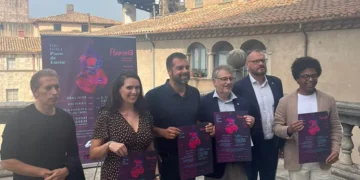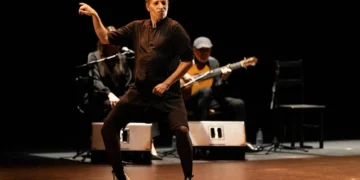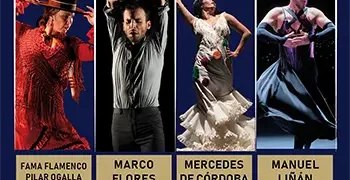|
Israel Galván “El final de este estado de cosas” |
||
|
Texto: Estela Zatania La Truco, Inmaculada Ortega, La Talegona, Miguel Cañas Dance: La Truco, Inmaculada Ortega, Carmen la Talegona, Miguel Cañas. Cante: Talegón de Córdoba, José Jiménez “Pepe Bocadillo”. Guitar: Antonio Españadero, Antonio Sánchez. Percussion: Kike Terrón. Flute: Omar Acosta. An ambitious work opened Friday’s program at the 2008 Festival de Jerez. With an aroma of the nineteen-seventies, when Mario Maya’s first works broke the previous mold, three women and one male dancer, all four experienced professionals, interpreted a complex script which not even with the off-stage voice explaining each scene was able to decipher. Nevertheless, there is a good level of dance, particularly in the women. You gather it is a story of love, longing and disappointment in which the four characters are Melancholy, Subjugation, Sweet Loss and Prejudice (like I said, “an ambitious work”) who dance out their messages in long numbers that include siguiriyas with debla, alegrías, soleá and tangos. This sincere work by people who are clearly serious and dedicated, did not have a completely satisfactory result, but with a director to do some serious cutting, and better cante and guitar, the project could still be saved. Noteworthy was the fiesta finale in which the three women wore batas de cola.
Israel Galván Dance: Israel Galván. Cante: Diego Carrasco, Fernando Terremoto, Juan José Amador. Guitarra: Alfredo Lagos. Dance, palmas and compás: Bobote. Percussion: José Carrasco. Orthodox group: Ricardo Jiménez, Marco Serrato, Borja Díaz. Violin: Eloísa Sánchez. Bandurria: José Manuel Vaquero “Pájaro”. Proyecto Lorca: Antonio Moreno, Juan Jiménez Alba. Choreography: Israel Galván. I was curious about the Japanese dance genre “butoh” Israel Galván uses to open “El Final de Este Estado de Cosas” [‘the end of this state of affairs’], and learned it is a style created in 1959 which, at the time, was called “grotesque, insulting and lacking in any sort of artistic worth […], a dance of the absurd, of human beings in their most primal state, of the absence of design or style”. So it’s understandable, and I say this without sarcasm, that Galván felt an affinity for this type of dance, and considered it an apt prologue to his complicated work that reflects the Apocalypse no less. Israel reserves the right to do whatever he well pleases because he has earned the status of genius, and this genius is attracted by that which is bizarre, embracing it and caressing it so thoroughly, he turns it into high art with the force of his personality. So while butoh dancing isn’t exactly soleá or siguiriyas, it has its impact and relevance within the work. The same cannot be said of the filmed segment that follows, containing a powerful antiwar message, the only weak element of the show in my opinion. Since we’re dealing with the Apocalypse, there are numerous religious or liturgical references. A Christmas tableau that figures in the program as “Christmas songs without Christmas, and it’s every man for himself” provides traditional “villancicos” for Israel to play and create, actions which are one and the same for this dancer. His vision is clear, you mustn’t take your eyes off him for a second, because each moment brings surprises. The program continues with “Virgins, prostitutes, guitars, cornets, drums and saetas”, which includes a dance with a large drum strapped to Galván, a saeta by Terremoto with heavy metal music to accompany and a slowly spinning ball of small mirrors that hangs from the ceiling like in old discotheques. “Siguiriyas with terremoto [the word also means ‘earthquake’] and famine and plague” is
He makes excellent use of pauses and sudden changes of speed, giving the sensation that he controls the march of real time. The flamenco feeling comes and goes, at times powerful, at times absent, always according to each individual’s personal flamencometer. All dance is acting, but if you think of Israel as an actor who dances very well, the product seems to have more meaning. And let’s not forget Diego Carrasco. With his guitar and his endless supply of witty charm, he sings psychodelic verses that are a cross between toná liviana, bamberas and caña. A delightful shirtless bulerías is provided by Bobote. “Death and the last dredges of the fiesta, infinitely” brings on the famous coffins, one for rapping out compás, another for Israel to dance within; an irreverant gesture that characterizes the whole work. Perhaps it’s true what I read about “butoh” dancing, that the person who practices it does so because somehow or other he truly has those natural instincts even before deciding to learn it. Be that as it may, flamenco dance is fortunate for having been touched by the genius of Israel Galván. Ezequiel Benítez, Antonio Malena A double bill of cante was offered at midnight in the Bodega de Los Apóstoles with two Jerez singers, Ezequiel Benítez and Antonio Malena. Young Ezequiel came accompanied by Daniel Méndez from Morón de la Frontera, and offered a varied menu that included soleá, cartagenera, a briskly-paced tientos in which he included a fandango in 4/4 time, fandangos de Huelva and bulerías in which he also inserted a fandango. For the closing fiesta, his delightful aunt jumped in with her bulerias dance. In the second part, Antonio Malena, who never quite manages to reproduce the power of his cante at age nine when he sang siguiriyas in the historic series Rito y Geografía del Cante, used his industrial-strength voice to interpret cantiñas, malagueñas with abandolao, soleá, serrana, siguiriyas and bulerías. |
Descubre más desde Revista DeFlamenco.com
Suscríbete y recibe las últimas entradas en tu correo electrónico.































